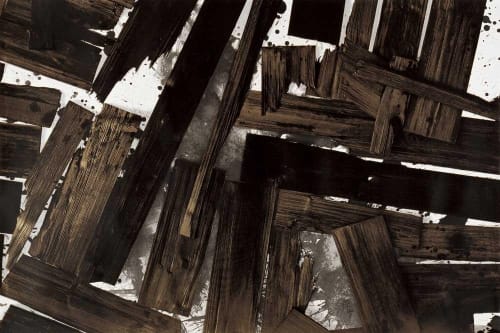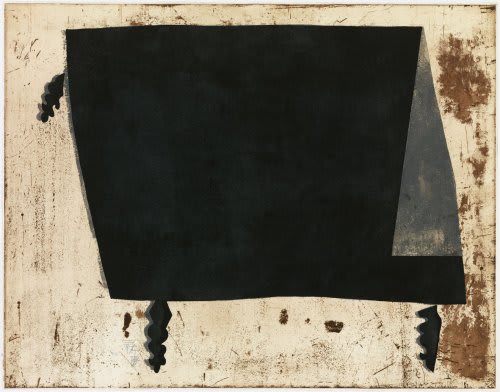Wang Huaiqing 王懐慶 China, b. 1944
王懷慶1944年初生於北京。1964年進入中央工藝美術學院,1979畢業於該院研究院。因受業於倡導西方現代主義的吳冠中門下,王懷慶受其影響甚篤。在文革期間的艱苦環境中,仍然嚴謹執著的發展出自己獨特的美學觀與藝術性格,成就其在當今中國藝術家中舉足輕重的地位。
展覽
1982年 參加法國巴黎春季沙龍展,創作油畫《畫家的母親》等作品
1983年 調至北京畫院任專職畫家,創作油畫《秋玉米》、《黃河水》及肖像作品
1984年 創作油畫《搏》,獲北京市美展甲等獎,由北京市美協收藏,參加第六屆全國美展
1985年 參加在黃山舉行的全國油畫研討會,創作油畫《四月》為中國美術館收藏,創作油畫《女孩與貓》、《夏趣》、《紅地毯》、《蓖麻》
1986年 創作系列作品《故園》、《三味書屋》等,中國美術館「當代油畫展」,中國美術館「國際藝苑首展」
1987年 美國紐約「王懷慶畫展」
1987年 紐約「中國當代油畫展」
1987年 日本東京「現代油畫展」
1987年 中國美術館「中國美術館藏品展」
1989年 重新放大創作86年的舊作《故園》,獲第七屆全國美展銅牌獎,為上海美術館收藏
1990年 創作油畫《雙椅》、《白墻襯托的立木四根》、《有一扇到另一房間的門》、《黑窗格剪碎白窗紙》等,開始創作中國水墨畫作品《妙齡》、《凝神》、《大海的生日》等
1991年 作品《大明風度》獲「91年中國油畫年展」金獎,
1991年 作品《走向世界的人》獲「當代油畫藝術國際展」二等獎,參加「吳冠中師生展」
1992年 北京「中國美術館藏品展」,
1992年 日本「第10屆上野之森美術館大獎展」
1992年 香港「91年中國油畫年展」
1993年 新加坡「王懷慶水墨展」
1993年 北京「中國美術館藏畫精品展」
1993年 德國海因巴赫「國際藝術節畫展」
1993年 中國美術館「中日現代繪畫展」,隨中國藝術家代表團出訪歐洲四國
1994年 中國美術館「第二屆全國油畫展」
1994年 新加坡「黑白之間–王懷慶水墨人體畫展」,出版《王懷慶水墨人體畫集》
1998年 紐約古根漢美術館「中國藝術5000年展」
1998年「傳統與回顧–當代中國藝術展」德國駐北京使館,作品收錄《中國現代美術全集》
1999年 台灣台北大未來畫廊「王懷慶個展」
1999年「中國美術館館藏精品展」
1999年 中國成都美術館「世紀之門展」
1999年「王懷慶個展」澳門市政廳畫廊,作品收錄《中國美術館藏品選》,中國中央電視台「名人名作專訪」
2000年 中國「上海2000雙年展」、中國美術館「20世紀–中國油畫大展」、作品收錄國家文化部重點文化工程「20世紀–中國油畫」大型畫冊,創作巨幅油畫《一生萬》等
2001年 中國美術館「科學與藝術展」獲優秀獎,創作油畫《沒家的家具》等
2002年 應西班牙Poligrafa公司與大未來畫廊之邀,赴巴塞羅那制作銅版畫5幅「巴塞爾藝術博覽會」
2005年 於香港展出作品個展,參加第二屆北京國際美術雙年展
2006年 台北國際藝術博覽會、新加坡藝術博覽會、北京藝術博覽會
Selected Exhibitions
1980
Same Generation Oil Painting Exhibition
China National Art Museum Beijing
1987
Contemporary Oil Paintings From the People’s Republic of China
Harkness House New York
1989
7th National Art Exhibition
China National Art Museum Beijing
1991
1st Annual Exhibition of Chinese Oil Painting
China National History Museum Beijing
1993
Exhibition of Selected Works from the Collection of National Art Museum
China National Art Museum Beijing
1996
1st Chinese Oil Painting Society Group Exhibition
China National Art Museum Beijing
1998
China 5000 Years Guggenheim Museum New York
The International Asian Art Fair
The Seventh Regiment Armory New York
Tradition and Retrospection – Exhibition of Chinese Contemporary Art
German Embassy Beijing
1999
Solo Show Ling and Keng Gallery Taipei
Asian Art Fair New York
Exhibition of Beijing Art Academy National Art Museum Beijing
Solo Show Leal Senado Temporary Exhibitions Gallery Macao
Exhibition of the Collection of China National Art Museum
National Art Museum Beijing
Gate of Century-Exhibition of Chinese Contemporary Art
Chengdu Art Museum Chengdu
2000
Exhibition of the Collection of Shanghai Art Museum
Shanghai Art Museum Shanghai
Exhibition of 21st Century Chinese Oil Painting National Art Museum Beijing
Connection of West and East-Exhibition of Contemporary Chinese Art
National Art Museum Beijing
Shanghai Biennale Shanghai Art Museum Shanghai
2001
Science and art China National Art Museum Beijing
Shanghai Jingwen Art Center show Shanghai
From Realism to Abstraction Ling and Keng gallery Taipei
2002
Gate of Masters-Exhibition of Chinese Contemporary Art
China National Museum Beijing
Basel Art Fair, Switzerland
2003
3rd National Exhibition of Oil Paintings
China National Museum Beijing
Master Show- From design to Art Shanghai
An Open Era-Celebration of 40th Anniversary of Founding of China National Museum of Fine Arts China National Museum
The 1st Beijing International Art Biennale China National Museum
The 2nd Chinese Art Academies Biennial Guangdong Art Museum
2004
Marianne & Heinrich Lenhardt-Stiftung Collections
Kaiserslautern Pfalzgalerie, Germany
2005
The 2nd Beijing International Art Biennale China National Museum Beijing.
Solo exhibition - Traces of Nature Exchange Center Hong Kong
Selected Books
1998 China 5000 Years-a Century in Crisis
published by Guggenheim Museum
1999 Collections of the China National Museum of Fine Arts
Published by China National Museum of Fine Arts
2000 Shanghai Biennale
published by Shanghai Lithograph & Art publishing house
2001 20th Century Chinese Oil Painting
published by Beijing publishing house
2002 An Opening Era
published by China National Museum of Fine Arts
2003 1st Beijing International Art Biennale
published by People’s Art publishing house
Honors
1984 First Award Beijing Art Exhibition
1989 Bronze Medal The 7th National Art Exhibition
1991 Gold Medal The 1st Annual Exhibition of Chinese Oil Painting
2003 Academic Award The 2nd Chinese Art Academies Biennale
說王懷慶的藝術
吳冠中
王懷慶從美術學院附中,大學,到研究生,受過嚴格科班鍛練,早年的具象油畫“伯樂相馬”及“搏”等贏得了他在美術界的實力派威望。後去美國兩年,他說他是帶着我的兩句話上飛機的:“只有中國的巨人才能同外國的巨人較量,中國的巨人只能在中國的土地上成長。”我說話總多偏激之詞,但王懷慶倒真的又回到了祖國大地。尋尋覓覓,他也在東尋西找,探索古,今。他長期馳騁于油畫彩色濱紛的疆場,後來卻鍾情于黑白視野了。這個切入口起先很窄,別人擔心他只在桌椅間討生活,前景堪懮. 這個切入口像一個山谷的入口,進入之後也許是絕壁死谷.將大哭而回,或柳暗花明,將發現新大陸.。
王懷慶起先注視紹興民居木樑木柱的構架,由於白墻的襯托,那構架縱橫穿插,傾斜支撐,充分顯示了力度的強勁,並自成宇宙一統.由此前進,他又愛上了明式傢具,桌,椅,板凳……結構更加精密,每件出色的傢具不止是一件精美的藝術品,更是一家之主,一國之主,他由此看到“大明風度”(他的一幅作品).
近十年的鑽研,這個王懷慶之谷顯得越來越開闊了,他從明式傢具的啓示進入了鋼筋鉄骨的鑄造,而他的鋼筋鉄骨的藍圖卻始于任性的,童心的揮寫,冰冷的軀體不失丹心碧血。
西方的克萊因(Kline),蘇拉日(Soulages)等不少畫家均在揣摩。吸取我國書法的黑白結構,而王懷慶的構架不止是單一的形式规範,因民族的魂魄,石濤的心眼,都啓示了王懷慶探索的方向。我對其作品的感受或聯想未必是作者的暗示,作者竭力發揮“黑”之威懾力,強調黑與白的交織,推敲肌理的鋪墊,經營無聲有序的生存空間,以孕育童心。
我們曾屬同一單位,因之“文化大革命”期間深識王懷慶,今見其新作,信乎風格即人格,其強勁的結構觀念正在步步展拓,其作品中的赤子之心日益鮮明,他默默拚搏,藝無涯。
Oil Painting Art of Wang Huaiqing
Wu Guanzhong
When kids are playing with toy bricks, they build with them, followed by pushing them down and repeat doing this time and time again, lost in arts creation.
Wang Huaiqng’s eyes were first focused upon the wood beam and pillar structures of Shaoxing residents, fully expressive of intensity of strength due to elaborate structure set off by white wall and reunion with universe. Then, he was attached to Ming-style furniture, like table, chair, bench and so on characterized by finer structure, each prominent one of which is more master of a household and king of a country than a perfect art article and through which he witnessed the ‘Grand Ming Style’(one of his works). However, he was lost to furniture not just for the sake of furniture or fell prey to the spell of cultural relics. Rather, he set hands on the dismantlement of structures elaborated by high-profile masters and was given to the restructuring of dismantled structures in the wake of knowledge of the original structures. He was committed to developing national tradition with a childlike innocence which dares to construct mansion with toy bricks.
Wang Huaiqing was strictly forged and trained in his discipline from the attached middle school of fine arts institute to university and graduate school and his early concrete oil paintings like ‘Bole Choosing Horse’ and ‘ Challenge’ won him fame and recognition in art circle as a talented artist. Later he was in US for two years and he told me that he was on board plane with two sentences I bestowed him, namely ‘ Only giants in China can be comparable to overseas counterparts and Chinese giants can take roots and grow only in China.’ My words, to be sure, are more often than not paranoia but Wang Huaiqing really returned to motherland again. He sought and sought everywhere and explored arts from ancient to modern. He shifted his favor from colorful oil painting to black-and-white view. This is a narrow cut-entrance, someone worry about that he limits his view among chairs and tables. Two possibilities are awaiting when one headed past a valley gate, namely, one had to retrace, crying mournfully for confronting precipice and dead valley and new horizon loomed with the disappearance of intimidating precipices. Due to a decade of research and study, Wang Huaiqing is increasingly versatile and eclectic in creation, finding expression in the revelation from Ming-style furniture to moldering of masculine works, hardened but affectionate and the inspiration of which originally derived from the willful childlike innocence. Tragic-awareness, however, can be smelt potentially existing in artistic creations. His ‘Evening Banquet’, to be quoted as an example, gives expression to the sentimental and emotional parting at the closing of a banquet against the black backdrop reminiscent of the lapsing and lost luxury. The work is set in black background, featured with contrast of thick and thin lines together with interweavement of horizontal and oblique streaks and incorporating classical poems and modern melodies; His latest works more often than not present radical revolution of disintegration and integration of traditional mindset: the horizontal and vertical parts of a shabby table combine to materialize a quiet and lean old man under a long sword falling from sky. Is it a threat or a protection in the critical moment? (A table in two different periods of time); Chairs are piled up increasingly high in acrobatic performance, accompanied by bewilderment in eye and suspense in heart (Performance of Chairs). ‘ Short Bench’ (representing all universe) is another example to show his perception of the revolution in traditional mindset; In ‘ Search’, dismantled legs and arms of furniture are searching for new homestead to settle; A transected table surface is supported by the cooperating thin unsteady legs with a pitch black pressing down on dark red space. Fortunately, two rising black columns prop up the surface, bring balance to universe of the picture. Vermeil patch is here emblematic of candle, eye, heart and sprinkled blood (Foot); 3-series ‘Sincerity Prevail’ is reflective of strength and force while 3-series ‘ Tranquility’ is set in deserted mountainous field and steep cliff invigorated by speedy stream. Qi Baishi wandered into forests to enjoy croaking of frogs coming along a long creek while Wang Huaiqing appreciates all kinds of sounds in nature through the eyes of a contemporary person.
Many artists in western world like Kline and Soulge, among others are contemplating to absorb nutrients from the black-and-white structure in our calligraphy but Wang Huaiqing’s structure is more than that and is traceable to national spirits and Chinese natural wonders as well. My understanding and imagination of Wang’s works is not necessarily based on his hints. Rather, they spring from the intimidating effect of black color widely employed by the artist who stresses the interweavement of black and white, context of texture as well as silent and orderly space to gestate and nurse childlike innocence.
I once wrote a short article titled < Agile Wang Huaiqing>. We were once on the same unit and well acquainted with him during ‘Cultural Revolution’. His personality finds its way to the style of his new works expressive of his increasingly expanded structural consciousness and a patriotic heart toiling and moiling with boundless creative ability in arts circle.





